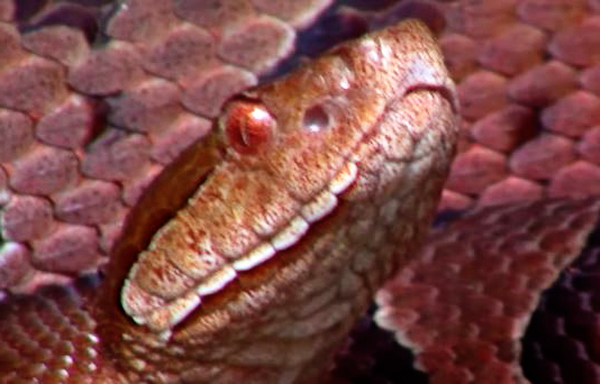- info@wildlifeanimalcontrol.com
Call us for help in your town
Wildlife Control Education
The Copperhead Snake
The Copperhead snake, scientifically referred to as “Agkistrodon Contortrix”, is a venomous snake found predominantly in North America. The Snake is also referred to as “Diamond snake”, “red snake” or “red oak”. The behavior of this snake often leads to accidental encounters with humans,

Appearance
A typical adult of this snake can grow up to 95cm in length, while some may exceed 1meter. Male species are normally larger than females, and makes could weigh averagely 198g while females weigh averagely less than 120g. The body of a typical Copperhead can be described as “stout” while the head is usually broader and appear distinct from the neck. The top of the head of this snake extends forward than its mouth. The color of a typical Copperhead snake may vary from Pale Tan to Pinkish ground color but this becomes darker towards the foreline. The snake has a pale-brown color at the center
Learn more: What to do if you find a shed snake skin
Biology
Copperhead is widely distributed, however its population is fast declining since early 2007. Foraging for this snake occurs mostly in warm sunny conditions, and it normally camouflage to capture its preys.
Life Cycle
mating occurs especially during the spring season and the female snake has its young ones live and can raise up to 20 or more at once, however, few offspring survive the first few days after birth. The exact lifespan of Copperhead is unknown but experts believe the specie does not live more than 54months. The snake grows quickly and attains full maturity in as little as 12 weeks. An average young Copperhead at birth measures about 20cm and looks lighter in color even though similar to the adult.
Habitat
Copperhead is widely distributed in the United States of America, including states such as Alabama, Ohio, Oklahoma, Missouri, New York and North Carolina. This specie of snake can inhabits diverse types of habitats, but it most resides in deciduous forests as well as mixed woodlands. It can also be found on rock outcroppings, and low swampy areas. The snake hibernates in dens during the cold winter seasons,
Diet
90% of Copperhead’s diet are derived from smaller rodents, especially from voles and mice. It also feeds on larger insects and frogs . Though the specie is regarded terrestrial in nature, it is also capable of climbing trees.
Find out more: Will a snake under a porch or shed have a nest of babies?
Behavior
Like most many native species of snakes in North America, the Copperhead likes to avoid humans, however, it will prefer to “Freeze” away instead of slithering away , and as a result, many humans are bitten when they accidentally step on Copperheads. Its camouflaging abilities make it difficult to spot from afar. They can lay on dead leaves, and will only strike when there is a physical contact. Though the Copperhead is a venomous snake, its bites are rarely fatal.
Go back to the How to get rid of snakes home page.
Need snake removal in your hometown? We service over 500 USA locations! Click here to hire us in your town and check prices - updated for year 2020.
Hi, I didn't see a link to your webmaster so I hope this gets to the correct person. I just saw a post by a mother in Texas whose child was bitten by a cottonmouth snake. She posted a photo and in my ignorance of snakes I would have sworn it was a copperhead. I would like to make a suggestion, because I'm sure there are other people out there who would believe the photo was a copperhead. The larger, main photo you show for a cottonmouth is what I always picture in my head and if I was skimming, I might not ever had made a connection that cottonmouths can be lighter with coppery colors, too. Please consider posting (maybe a side by side photo) of the one you have along with a lighter one so people, like me, won't mistakenly think that they are all a dark, almost black, looking color. Who knows, it could save a life.

















